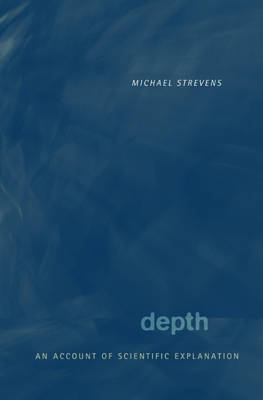
Depth
Harvard University Press (Verlag)
978-0-674-06257-3 (ISBN)
What does it mean for scientists to truly understand, rather than to merely describe, how the world works? Michael Strevens proposes a novel theory of scientific explanation and understanding that overhauls and augments the familiar causal approach to explanation. What is replaced is the test for explanatorily relevant causal information: Strevens discards the usual criterion of counterfactual dependence in favor of a criterion that turns on a process of progressive abstraction away from a fully detailed, physical causal story. The augmentations include the introduction of a new, non-causal explanatory relevance relation—entanglement—and an independent theory of the role of black-boxing and functional specification in explanation.
The abstraction-centered notion of difference-making leads to a rich causal treatment of many aspects of explanation that have been either ignored or handled inadequately by earlier causal approaches, including the explanation of laws and other regularities, with particular attention to the explanation of physically contingent high-level laws, idealization in explanation, and probabilistic explanation in deterministic systems, as in statistical physics, evolutionary biology, and medicine.
The result is an account of explanation that has especially significant consequences for the higher-level sciences: biology, psychology, economics, and other social sciences.
Michael Strevens is Professor of Philosophy at New York University. He received a Guggenheim Fellowship in 2017.
* List of Figures* and Table** * Preface * Part I. The Causal Approach to Explanation *1. Approaches to Explanation *1.1 Causal Explanation and Explanatory Relevance *1.2 Preliminaries *1.3 Accounts of the Explanatory Relation *1.4 The Causal Element in Explanation *1.5 The Pursuit of Explanation *2. Causal and Explanatory Relevance *2.1 The Minimal Causal Account of Event Explanation *2.2 The Problem of Relevance *2.3 The Probabilistic Solution *2.4 The Counterfactual Solution *2.5 The Manipulationist Solution * Part II. The Kairetic Account of Explanation *3. The Kairetic Account of Difference-Making *3.1 Overview of the Kairetic Account *3.2 Causal Models *3.3 States of Affairs *3.4 The Eliminative Procedure *3.5 Abstraction and Optimizing *3.6 Cohesion *3.7 The Optimizing Procedure *3.8 Rival Accounts of Difference-Making Reconsidered *4. The Kairetic Account of Explanation *4.1 Standalone Explanation *4.2 Difference-Making and Transitivity in Compound Explanations *4.3 Comparing Standalone Explanations *4.4 Laplacean Blindness *5. Extending the Kairetic Account *5.1 Quantifying Explanatory Relevance *5.2 Trading Off Accuracy for Generality *5.3 The Explanatory Framework *5.4 Black Boxes, Functional Properties, and Multiple Realizability *5.5 Aggregative Explanation *5.6 Contrastive Explanation *5.7 Beyond Causal Explanation *6. Event Explanation and Causal Claims *6.1 Background Conditions versus Causes *6.2 Preemption *6.3 Nonevents as Difference-Makers *6.4 Nonevents as Explananda *6.5 Transitivity *6.6 Three Kinds of Causation * Part III. Explanation of Laws and Regularities *7. Regularity Explanation *7.1 Approaches to Regularity Explanation *7.2 Explaining Laws with Mechanisms *7.3 Basing Generalizations *7.4 Property Laws *7.5 Other Laws *7.6 The Metaphysics of High and Low *8. Abstraction in Regularity Explanation *8.1 Problems of Abstraction in Regularity Explanation *8.2 Explaining Boyle's Law *8.3 A Theory of Idealization *8.4 Mathematically Driven Explanation * Part IV. Probabilistic Explanation *9. Approaches to Probabilistic Explanation *9.1 Explanatory Questions *9.2 Varieties of Probabilistic Explanation: Examples *9.3 Varieties of Probabilistic Explanation: Commentary *9.4 Accounts of Probabilistic Explanation *9.5 Elitism versus Egalitarianism *9.6 Probability and Determinism *9.7 Formal Elements of the Kairetic Approach *10. Kairetic Explanation of Frequencies *10.1 Probabilistic Explanation in Deterministic Systems *10.2 Explanation with Complex Probability *10.3 Explanation with Quasiprobability *10.4 Elitism versus Egalitarianism the Kairetic Way *10.5 Regularity Explanation and Probabilistic Metaphysics *11. Kairetic Explanation of Single Outcomes *11.1 Single Outcome Explanation *11.2 Robustness *11.3 Nonexplanatory Probability-Raisers *11.4 Nonexplanatory Critical Events *11.5 Elitism and Egalitarianism Revisited * Part V. Valediction *12. Looking Outward *12.1 Biology: Probabilistic Explanation *12.2 Psychology: Content and Explanation *12.3 Economics: Abstraction *12.4 Explanatory Autonomy *13. Looking Inward * Notes * References * Index ** Figures *2.1 The counterfactual and manipulationist tests for difference-making contrasted *3.1 A compound causal model for a window's breaking *4.1 A compound standalone explanation *4.2 Intensification: inserting an intermediate setup *4.3 The structure of a hybrid causal model *6.1 A single event as both a backup cause and an actual cause *7.1 A bridge diagram for interlevel explanation *9.1 Examples of probabilistic causal models *10.1 An evolution function for a simple wheel of fortune *10.2 A probability density function over initial conditions *10.3 The frequency produced by a microconstant evolution function is equal to the strike ratio, provided that the initial-condition density is macroperiodic *10.4 A nonmacroperiodic initial-condition density over a microconstant evolution function may produce a frequency that differs from the strike ratio *10.5 An evolution function with imperfect microconstancy *11.1 A probabilistic model for a bombing death expanded to show all probabilistic outcomes *11.2 An alternative expanded probabilistic model for a bomb-related death *11.3 A typical microconstant explanation of a long-run frequency expanded to show the probabilistic derivation's route through the macroperiodicity of the actual initial-condition distribution *** Table *9.1 Positions in the elitism/egalitarianism debate
| Erscheint lt. Verlag | 30.10.2011 |
|---|---|
| Zusatzinfo | 16 line illustrations, 1 table |
| Verlagsort | Cambridge, Mass |
| Sprache | englisch |
| Maße | 156 x 235 mm |
| Themenwelt | Geisteswissenschaften ► Philosophie ► Erkenntnistheorie / Wissenschaftstheorie |
| Geisteswissenschaften ► Philosophie ► Logik | |
| Naturwissenschaften | |
| ISBN-10 | 0-674-06257-4 / 0674062574 |
| ISBN-13 | 978-0-674-06257-3 / 9780674062573 |
| Zustand | Neuware |
| Haben Sie eine Frage zum Produkt? |
aus dem Bereich

![Was heißt Denken?. Vorlesung Wintersemester 1951/52. [Was bedeutet das alles?] - Martin Heidegger](/media/113619842)
